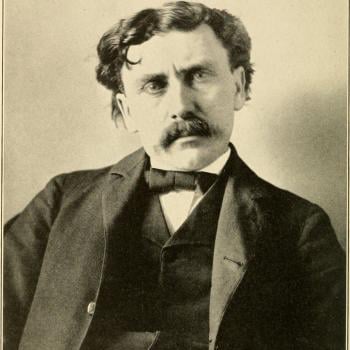I recently discovered a new word that will be really useful for me in writing about Christian history. It describes an important and enduring category or type of belief that I have long known about, and in various historical eras, but for which I have never really had the ideal term.
I was in conversation with the excellent and widely published scholar of religion, Linda Woodhead, who is based at Lancaster, in north-west England. In correspondence, she mentioned an early seventeenth century sect called the Grindletonians, who can best be thought of as forerunners of the Quaker movement, and who emerged in that same area. She described them as “Antinomian, Spirit-led, immanentists,” a phrase that gave me a perfect sense of who the sect members were, and what they believed. But the word itself came as a surprise. Immanentist?
To over-simplify, God can be portrayed as transcendent (beyond and above the world, and humanity) or as immanent (within). An immanentist believes that God is entirely or mainly within the individual person, and that idea conditions attitudes to spiritual authority. In this view, the Bible has enormous spiritual authority, but it has to be read in a spiritual and psychological sense, as it speaks to the individual soul. That esoteric doctrine links naturally to a rejection of the Law, antinomianism. Commonly, but not necessarily, belief in the God Within shades into a doctrine of pantheism, the idea that all is holy.
I had come across the word immanentism before, mainly in a Catholic context and with a rather different and more philosophical setting. It can be defined as “A tendency to understand the immanence of God or of His action in us in such a way that it would, in fact, exclude the reality of His transcendence.” What Linda Woodhead is doing – and this is her own coinage – is applying it in a way that is very useful indeed for anyone who studies the Radical Reformation, or the Anglo-American religious world of the seventeenth and eighteenth centuries, or the early nineteenth century US. On several occasions, I have myself written about people who began with an intense belief in God and Christ as imagined in a fairly conventional way. Over time, though, they develop a more mystical approach, to believe in God as an inner reality, an inner light, so that Christ is within.
You can call them God-Within-ists, or Inner-Lightists; but immanentists is much better, and more accurate.
I blogged about the radical mystic Gerrard Winstanley, for whom the Biblical rivers flowing out of Paradise were identical with the five senses of the individual human being: the Bible was portraying internal realities. Eden is within. Winstanley came from a radical Puritan background, and we can identify many others in seventeenth century England who followed a somewhat similar trajectory. Most began in some version of Anabaptism. Many ended up in the Quaker sect that was formed in the 1650s, and which absorbed most of the fringe extremist groups of the era.
In the context of the Middle Ages or the Early Modern periods, immanentist ideas had grave and potentially lethal political consequences. Believers were presenting their own individual inspiration against established churches that proclaimed their absolute monopoly on spiritual gifts. Did the believers not claim to hear the voice of God within themselves? Of necessity, the radicals tended to be anti-institutional, anti-hierarchical, anti-clerical. Preaching as they did a fundamental principle of human equality, the radicals also contained a sizable female presence, with women claiming full rights to teach, preach, and prophesy. How could they fail to endure repeated confrontations with state mechanisms?
Often, orthodox critics launched ferocious attacks on such mystical and esoteric believers, depicting them as atheists, or as mockers of the Bible, or blasphemers. That is a gross misunderstanding – although historically, the sects that espouse these ideas in one generation often did later gravitate to skeptical and rationalist views. Historically, the Inner Light ultimately did create the pre-conditions for Enlightenment.
So, where do we find these immanentists? We would look at the medieval Brethren of the Free Spirit, the Family of Love in the sixteenth and seventeenth centuries, and the English Ranters and early Quakers. We could find many later manifestations in the early American Republic, and the sects and cults that flourished in the 1840s and beyond. In some cases, we can trace linkages between the various sects, but the ideas do naturally spring up of their own accord. We can in fact see many parallels in other religions, including in the Sufis of Islam, and various batiniya [inward, or esoteric] sects.
A great deal has obviously been written on these various groups, not least in the classic English historical studies by Norman Cohn and Christopher Hill, or Alastair Hamilton’s The Family of Love (Cambridge University Press, 1981). More recently, see David R. Como’s substantial study Blown By The Spirit: Puritanism And The Emergence Of An Antinomian Underground In Pre-Civil War England (Stanford University Press, 2004).
I have an article due out shortly in Fides et Historia which offers a case-study of one alleged seventeenth century “atheist,” who on closer examination belonged to a larger grouping tied to early Quakerism. They fit perfectly into this mystical, radical, esoteric, post-Puritan, antinomian model – of immanentists, in fact. I’ll talk more about the scandalous case of Colonel Henry Bowen in a later blog.
By the way, that “post-Puritan” category might also be worth some exploration!













